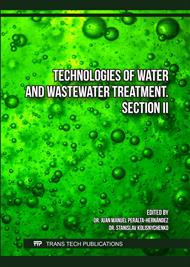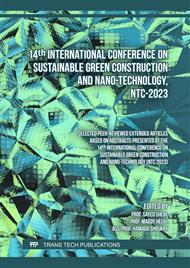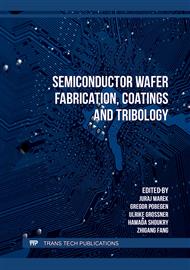[1]
N. A. S. M. A. El-Khateeb, and Hussein M. Ahmed, "Effective granular activated carbon for greywater treatment prepared from corncobs," Egypt. J. Chem., 2022.
DOI: 10.21608/ejchem.2022.117621.5302
Google Scholar
[2]
S. Ranga, "Bentonite used as natural coagulant and adsorbent: A review Sweety Ranga," ~ 155 ~ Pharma Innov. J., vol. 7, no. 7, p.155–157, 2018, [Online]. Available: www.thepharmajournal.com
Google Scholar
[3]
K. P. T Janani, J.S. Sudarsan, "Grey water recycling with corn cob as an adsorbent," in The 11th National Conference on Mathematical Techniques and Application, 2019, p.1–7.
DOI: 10.1063/1.5112366
Google Scholar
[4]
D. Suteu, T. Malutan, and D. Bilba, "Agricultural Waste Corncob as a Sorbent for Removing Reactive Dye Orange 16: Equilibrium and kinetic Study," Cellul. Chem. Technol., vol. 45, no. 5–6, p.413–420, 2011.
Google Scholar
[5]
L. B. Ravindra D. Kale, Sangeeta Barwar, and Prerana Kane, "Green synthesis of magnetite nanoparticles using banana leaves," Eur. J. Sci., vol. 1, no. 1, p.26–34, 2018.
DOI: 10.29198/ejs1803
Google Scholar
[6]
R. S. Prema, and S. Kandasamy, "Methods of synthesis of nano particles and its applications," J. Chem. Pharm. Res., vol. 7, no. 3, p.278–285, 2015.
Google Scholar
[7]
R. G. Amany, M. S. an. Nagwa, S. H. Ahmed, and Y. A. Abdelmoteleb, "Biosynthesis, characterization and antimicrobial activity of iron oxide nanoparticles synthesized by fungi," Az. J. Pharm Sci, vol. 62, p.164–178, 2020.
Google Scholar
[8]
J. K. P. Gitishree Das, Han-Seung Shin, Anuj Kumar, and Chethala N. Vishnuprasad, "Photo-mediated optimized synthesis of silver nanoparticles using the extracts of outer shell fibre of cocos nucifera L. fruit and detection of its antioxidant, cytotoxicity and antibacterial potential," Saudi J. Biol. Sci., vol. 28, p.980–987, 2021.
DOI: 10.1016/j.sjbs.2020.11.022
Google Scholar
[9]
M. S. M. M. and Hussein I. Abdel-Shafy1, "Green synthesis of metallic nanoparticles from natural resources and food waste and their environmental application," in Green Metal Nanoparticles, 2018, p.321–386.
DOI: 10.1002/9781119418900.ch11
Google Scholar
[10]
N. Carter, "Physical properties of iron oxide nanoparticles," 2015.
Google Scholar
[11]
A. T. E. A. and, Enshirah Da'na, "Green synthesis of iron nanoparticles by acacia nilotica pods extract and its catalytic, adsorption, and antibacterial activities," Appl. Sci., vol. 8, no. 1922, p.1–17, 2018.
DOI: 10.3390/app8101922
Google Scholar
[12]
H. P. W. Yuan-Pang Sun, Xiao-qin Li, Jiasheng Cao, and Wei-xian Zhang, "Characterization of zero-valent iron nanoparticles," Adv. Colloid Interface Sci., vol. 120, p.47–56, 2006.
DOI: 10.1016/j.cis.2006.03.001
Google Scholar
[13]
M. Majlesi, "Preparation and adsorption properties of chitosan-bound Fe3O4 magnetic nanoparticles for phenol removal from aqueous solution," World Rev. Sci. Technol. Sust. Dev., vol. 12, no. 4, p.371–380, 2016.
DOI: 10.1504/wrstsd.2016.10003098
Google Scholar
[14]
J. B. P. Sen and Dhermendra K. Tiwari, "Application of nanoparticles in waste water treatment," World Appl. Sci. Journa, vol. 3, no. 3, p.417–433, 2008.
Google Scholar
[15]
Dalia Abdul Elah Mohammad and Eman Mohammad Taher, "Antimicrobial activity of silver nanoparticles fabricated from some vegetable plants," J. Phys., p.1–13, 2019.
DOI: 10.1088/1742-6596/1294/6/062048
Google Scholar
[16]
Z. Kheilkordi and M. Ziarani, "Recent advances in the application of magnetic bio-polymers as catalysts in multicomponent," RSC Adv., vol. 12, p.12672–12701, 2022.
DOI: 10.1039/d2ra01294d
Google Scholar
[17]
"Egyptian environmental association affair (EEAA), law 48, 1982, permissible values for wastes in river nile and Law 44, Law of the environmental protection 1994, updating 2000".
Google Scholar
[18]
APHA., "Standard methods for the examination of water and wastewater," Am. Water Work. Public Work. Assoc. Environ. Fed, 2017.
Google Scholar
[19]
F. M. A.-H. Hussein. I. Abdel-Shafy, Mohamed. M. Hefny, and Hussein. M. Ahmed, "Removal of cadmium, nickel, and zinc from aqueous solutions by activated carbon prepared from corncob - waste agricultural materials," Egypt. J. Chem., 2021.
DOI: 10.21608/ejchem.2021.85296.4227
Google Scholar
[20]
K. N. I. Sadon, F. N., and Ahmmed Saadi Ibrahem, "An overview of rice husk applications and modification techniques in wastewater treatment," J. Purity, Util. React. Environ., vol. 1, no. 6, p.308–334, 2012.
Google Scholar
[21]
M. A. Mahmoud, "Thermodynamics and kinetics studies of Mn (II) removal from aqueous solution onto powder corn Cobs (PCC)," J. Chromatogr. Sep. Tech., vol. 06, no. 07, 2015.
DOI: 10.4172/2157-7064.1000301
Google Scholar
[22]
"Biosysnthesis, characterization and antimicrobial activity of iron oxide nanoparticles synthesized by fungi," Az. J. Pharm Sci, vol. 62, p.164–179, 2020.
Google Scholar
[23]
A. B. J. Babak Kakavandi, Roshanak Rezaei Kalantary, Mahdi Farzadkia, Amir Hossein Mahvi, Ali Esrafili, Ali Azari, and Ahmad Reza Yari, "Enhanced chromium (VI) removal using activated carbon modified by zero valent iron and silver bimetallic nanoparticles," J. Environ. Heal. Sci., vol. 12, no. 115, p.1–10, 2014.
DOI: 10.1186/s40201-014-0115-5
Google Scholar
[24]
M. M. E. Omar E. Abdel Salam, and Neama A. Reiad, "Waste water treatment by Tea Waste, Alum, Pre-Aluminium Chloride," J. Adv. Res., vol. 2, p.297–303, 2011.
Google Scholar
[25]
A. Lakshmi Narayanan, and Venkatesan, "A batch Studies on Adsorption of Nickel(II) Using Redmud," Int. J. Adv. Res., vol. 1, no. 9, p.465–472, 2013.
Google Scholar
[26]
B. U. A. M.A.O. Badmus, and T.O.K. Audu, "Removal of lead ion from industrial wastewaters by activated carbon prepared from periwinkle shells," (Typanotonus fuscatus), Turkish J. Eng. Environ. Sci., vol. 31, no. 4, p.251–263., 2007.
DOI: 10.1007/s11814-007-5049-5
Google Scholar
[27]
T. A. Taylor, and Saleh, "Desalination and water treatment nanocomposite of carbon nanotubes / silica nanoparticles and their use for adsorption of Pb ( II ): from surface properties to sorption mechanism," p.37–41, 2015.
DOI: 10.1080/19443994.2015.1036784
Google Scholar
[28]
D. E. S. M.J. Zamzow, B.R. Eichbaum, and K.R. Sandgren, "Removal of heavy metals and other cations from wastewater using zeolites," Sep. Sci. Technol, vol. 25, p.1555–1569, 1990.
DOI: 10.1080/01496399008050409
Google Scholar
[29]
Y. J. R. Han, Z. Lu, W. Zou, W. Daotong, and J. Shi, "Removal of copper(II) and lead(II) from aqueous solution by manganese oxide coated sand," J. Hazard. Mater., vol. 137, no. 1, p.480–488, 2006.
DOI: 10.1016/j.jhazmat.2006.02.018
Google Scholar
[30]
A. K. Ola Abdelwahab, Ahemed ELnemer, and Amany EL sikaily, "USE of rice husk for adsorption ofdirect dyes fromaqueous solution," Egyption J. Aquat. Res., vol. 31, no. 1, p.2–16, 2005.
Google Scholar
[31]
M. S. M. M. Saad S M Hassan, and Hussein I Abdel-Shafy, "Removal of pyrene and benzo(a)pyrene micropollutant from water via adsorption by green synthesized iron oxide nanoparticles," Adv. Nat. Sci. Nanosci. Nanotechnol., vol. 9, no. 015006, p.1–14, 2018.
DOI: 10.1088/2043-6254/aaa6f0
Google Scholar
[32]
A. T. Sabzoi Nizamuddin, M.T.H Siddiqui, N.M. Mubarak, Humair Ahmed Baloch, E.C. Abdullah, Shaukat A. Mazari, G.J. Griffin, and M.P. Srinivasan, "Iron oxide nano materials for the removal of heavy metals and dyes from wastewater," in Removal of heavy mtals and dyes from wastewater, 2018, p.447–472.
DOI: 10.1016/b978-0-12-813926-4.00023-9
Google Scholar
[33]
E. D. N. Chiron, and R. Guilet, "Adsorption of Cu(II) and Pb(II) onto a grafted silica: Isotherms and kinetic models," Water Res., vol. 37, p.3079–3086, 2003.
DOI: 10.1016/s0043-1354(03)00156-8
Google Scholar
[34]
I. A. and V.K. Gupta, "Removal of lead and chromium from wastewater using bagasse fly ash—A sugar industry waste," J. Colloid Interface Sci., vol. 271, no. 2, p.321–328., 2004.
DOI: 10.1016/j.jcis.2003.11.007
Google Scholar
[35]
A. A. Saif Ullah Khan, Rumman Zaidi, Saeikh Z. Hassan, and I. H. Farooqi, "Application of Fe-Cu binary oxide nanoparticles for the removal of hexavalent chromium from aqueous solution," Water Sci. Technol., p.165–175, 2016.
DOI: 10.2166/wst.2016.172
Google Scholar




